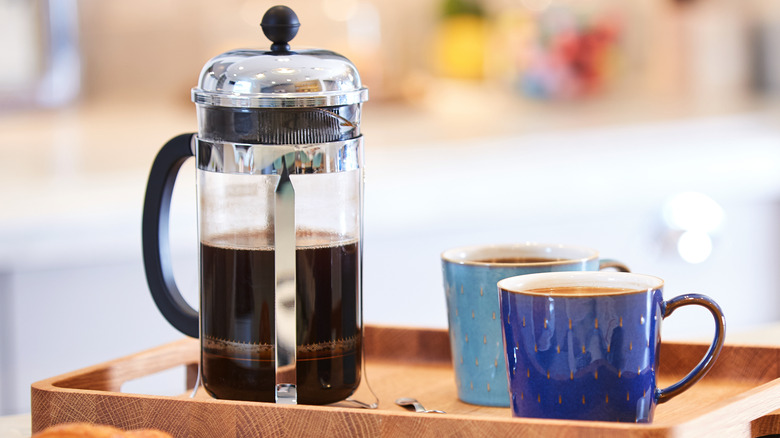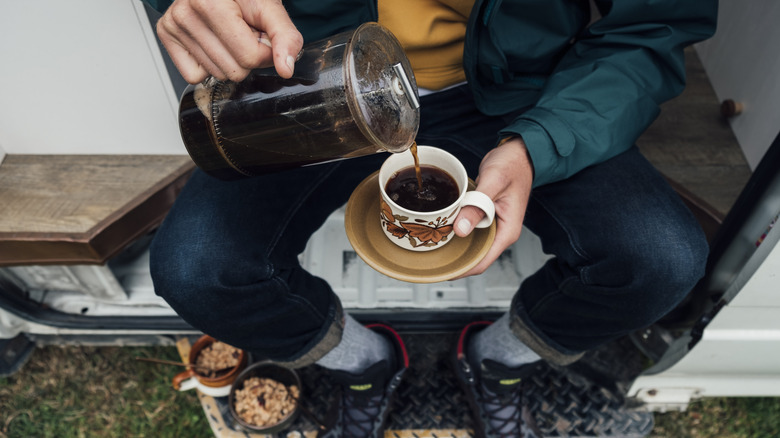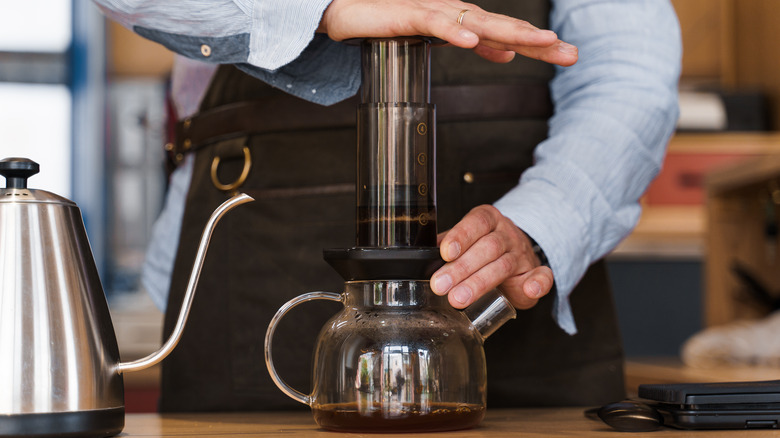What's The Difference Between A French And AeroPress?
If you spend any time researching how to get the best coffee at home, you'll likely come across the French press and the AeroPress time and time again. Both of these coffee brewers use some version of a plunger system to push the grounds down and extract the flavor and caffeine from the beans. But they are not synonymous, due to a few key differences.
French presses rely on giving coffee grounds adequate time to steep in water before being separated by a set of filter discs, which produces a robust but somewhat diluted cup of coffee — something fairly similar to American coffee. AeroPresses on the other hand don't need much time at all for their extraction process. Instead of relying on time to allow the water to draw the oils and flavor from the coffee beans, AeroPress extracts flavor by force thanks to its plunger. While these differences may seem minor, both coffee presses produce wildly different brews.
The benefits of a French press
The French press reigns supreme if you're making coffee for multiple people each morning, or like to drink a few cups on your own, since you can make a full pot. French presses come in a wide variety of materials, including glass, plastic, or stainless steel. Glass presses are lovely to look at, but can break somewhat easily. If you need a more durable brewer or plan on regularly machine washing your press, opt for the stainless steel or BPA-free plastic models.
French presses are essentially coffee pitchers that can brew multiple cups of coffee at a time. The magic of the French press is in its lid, which has a plunger that is essentially a long stem with filter discs attached. These filter discs have small to medium-sized holes that filter larger coffee grounds out but may leave you with some fine-particle sediment — think of the French press filters as a colander you might use to wash salad, but not to drain rice.
After the coffee grinds have had enough time to steep in the water, you press the plunger down and are left with your coffee. The French press hot brewing method will get you something very close to an American drip coffee, and it's also kind of perfect for making cold brew. While a hot French press brew will take three to five minutes, cold brew needs to be left out for several hours, usually overnight, to avoid a weak, watery brew.
Less might be best with AeroPress
Unlike many coffee brewers, AeroPress can only make one cup of coffee at a time and is brewed directly over a coffee cup, making it best-suited to individuals who don't need to bulk brew. At first glance, the AeroPress may seem identical to single-serve coffee cup drippers, but it uses a plunger — and the force produces a more concentrated cup of coffee. The durable but lightweight BPA-free plastic makes it a favorite for folks who want a portable coffee maker for travel and camping.
You can use both paper and stainless steel filters on an AeroPress — the paper ones work fine for easy cleanup but hold onto coffee oils, which can produce less flavorful coffee. The stainless steel filter is made from a fine mesh sieve, sort of like a removable espresso portafilter. This results in less sediment and what coffee enthusiasts describe as a "cleaner" cup of coffee.
AeroPress coffee is much more concentrated and generally less acidic than French press coffee, so you can drink it as is (similar to espresso), or dilute it with water for a more classic drip coffee. With a more concentrated brew, you can riff on espresso-style drinks such as lattes and café au lait. And while it's not good for making cold brew, you can easily dilute the hot espresso-style coffee with milk and ice if you prefer a chilled beverage.


